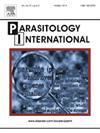Prevalence and genetic diversity of Theileria and Anaplasma species infecting cattle in Paraguay
IF 1.5
4区 医学
Q3 PARASITOLOGY
引用次数: 0
Abstract
Bovine theileriosis and anaplasmosis are major tick-borne diseases affecting cattle health and productivity worldwide. Although cattle farming significantly contributes to Paraguay's economy, limited epidemiological data on the causative agents hinder the formulation of disease control measures. To address this challenge, the present study investigated the prevalence, risk factors, and genetic diversity of Theileria annulata, Theileria orientalis, and Anaplasma marginale among cattle populations in Paraguay. Blood DNA samples from 326 cattle in nine departments of Paraguay were screened with the pathogen-specific PCR assays. All three pathogens were detected with A. marginale (18.0 %) being the most prevalent, followed by T. orientalis (2.4 %) and T. annulata (1.5 %). In addition, further screening of A. marginale-negative samples using two PCR assays targeting the 16S rRNA and groEL genes of Anaplasma spp., followed by sequencing, detected an infection with Candidatus Anaplasma cinensis. We observed significantly higher A. marginale-positive rates in the Eastern region, males, and extensively managed cattle, as compared to those in the Western region, females, and semi-intensively managed cattle, respectively. Phylogenetic analyses revealed that T. annulata tams1 gene sequences were diverse and occurred in multiple clades, while T. orientalis mpsp gene sequences clustered into the genotypes 1, 2, and 3. In contrast, A. marginale msp5 gene sequences occurred within a single clade, suggesting a low genetic diversity. In conclusion, the detection of T. annulata, T. orientalis genotype 2, and A. marginale indicates that cattle populations in Paraguay are at risk of clinical theileriosis and anaplasmosis, highlighting the need to develop disease management strategies.

巴拉圭牛感染伊氏菌和无原体的流行率和遗传多样性
牛蛲虫病和无形体病是影响全世界牛健康和生产力的主要蜱传疾病。虽然养牛对巴拉圭的经济作出了重大贡献,但有关病原体的流行病学数据有限,阻碍了疾病控制措施的制定。为了应对这一挑战,本研究调查了巴拉圭牛种群中环状铁杆菌、东方铁杆菌和边缘无原体的流行率、危险因素和遗传多样性。用病原体特异性PCR分析筛选了巴拉圭9个省326头牛的血液DNA样本。3种病原菌均以边缘蜱(18.0%)最常见,其次为东方蜱(2.4%)和环状蜱(1.5%)。此外,利用针对无形体(anapplasma spp.) 16S rRNA和groEL基因的两种PCR方法进一步筛选边缘a阴性样本,并进行测序,检测到中国无形体(Candidatus anapplasma cinensis)感染。我们观察到东部地区、雄性和粗放型管理牛的A.边缘阳性率显著高于西部地区、雌性和半集约型管理牛。系统发育分析表明,环孢T. tams1基因序列具有多样性,存在于多个进化支中,而东方T. mpsp基因序列集中在1、2和3基因型中。相比之下,边缘叶麻的msp5基因序列出现在一个分支中,表明其遗传多样性较低。总之,圆环绦虫、东方绦虫基因2型和边缘绦虫的检测表明,巴拉圭的牛种群面临着临床蛲虫病和无形体病的风险,强调了制定疾病管理战略的必要性。
本文章由计算机程序翻译,如有差异,请以英文原文为准。
求助全文
约1分钟内获得全文
求助全文
来源期刊

Parasitology International
医学-寄生虫学
CiteScore
4.00
自引率
10.50%
发文量
140
审稿时长
61 days
期刊介绍:
Parasitology International provides a medium for rapid, carefully reviewed publications in the field of human and animal parasitology. Original papers, rapid communications, and original case reports from all geographical areas and covering all parasitological disciplines, including structure, immunology, cell biology, biochemistry, molecular biology, and systematics, may be submitted. Reviews on recent developments are invited regularly, but suggestions in this respect are welcome. Letters to the Editor commenting on any aspect of the Journal are also welcome.
 求助内容:
求助内容: 应助结果提醒方式:
应助结果提醒方式:


